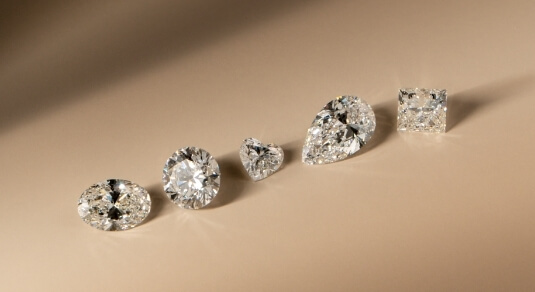Diamonds are a symbol of elegance, timeless beauty, and luxury. The cut of a diamond significantly influences its overall appearance, brilliance, and sparkle. The diamond cut refers to how well the diamond’s facets are proportioned and shaped to enhance its visual appeal. Although people often confuse “cut” with “shape,” they are two different things: shape refers to the overall form (round, princess, etc.), while cut refers to the craftsmanship of the stone.
In this article, we will explore the most popular types of diamond cuts, from the classic round brilliant to lesser-known cuts that offer a unique appeal.
1. Round Brilliant Cut
The Round Brilliant Cut is the most iconic and popular diamond cut. Its shape is round, and it is known for its exceptional sparkle and brilliance. With 57 to 58 facets (including the culet), the round brilliant cut is designed to maximize the reflection of light, which gives it a stunning, fiery glow. The round cut has been a staple in engagement rings for decades because of its ability to maximize a diamond’s potential. Its symmetry and light performance make it a top choice among jewelers and consumers alike.
Best for: Engagement rings, classic jewelry, timeless style.
2. Princess Cut
The Princess Cut is one of the most popular fancy shapes for diamonds, offering a modern twist on the round brilliant. This cut is square or rectangular, with pointed corners that create a sharp, angular appearance. It features a high degree of brilliance and sparkle, thanks to its numerous facets. While the princess cut may not reflect light as well as the round brilliant, its edgy, contemporary look makes it a favorite among those seeking a stylish alternative.
Best for: Engagement rings, modern settings, and a chic, contemporary style.
3. Emerald Cut
The Emerald Cut is an elegant step cut, characterized by its long, rectangular facets. Unlike the round or princess cuts, the emerald cut prioritizes clarity over brilliance. Its large, open facets allow light to flow through the diamond, creating a unique, understated sparkle. The emerald cut highlights the diamond’s clarity and often showcases an antique, vintage feel. While it doesn’t boast the same fire as other cuts, its simplicity and elegance make it a sophisticated choice for those who prefer a more refined look.
Best for: Vintage-style jewelry, high-quality diamonds, and minimalistic designs.
4. Cushion Cut
The Cushion Cut combines elements of both the round brilliant and the emerald cut, with its square shape featuring rounded corners. This cut is known for its romantic, vintage appeal. It creates a softer, more subtle brilliance compared to the round brilliant cut but still offers excellent sparkle. Cushion cuts often have a unique, “pillow-like” appearance, which is why it’s often chosen for engagement rings and other fine jewelry.
Best for: Vintage-inspired pieces, engagement rings, and those seeking a blend of classic and modern style.
5. Asscher Cut
The Asscher Cut is very similar to the emerald cut but with a square shape and deeper facets. Its step-cut design creates a hall-of-mirrors effect, with dramatic flashes of light that give the diamond a vintage feel. The Asscher cut is known for its elegant appearance, and it has become a popular choice for those who want something both timeless and unique.
Best for: Art Deco-inspired pieces, vintage jewelry, and those desiring a bold yet refined cut.
6. Radiant Cut
The Radiant Cut is a square or rectangular shape with trimmed corners, offering the brilliance of the round brilliant cut combined with the elegant shape of the emerald cut. This cut has a high number of facets, which results in exceptional sparkle. The radiant cut is versatile and works well in both modern and traditional jewelry settings.
Best for: Versatile jewelry, contemporary settings, man made diamonds, and those who like a balance of sparkle and elegance.
7. Marquise Cut
The Marquise Cut is an elongated shape with pointed ends, giving the diamond an oval appearance with a distinctive, elegant flair. It is often considered a symbol of luxury and sophistication, and its elongated shape can make the diamond appear larger than it actually is. The Marquise Cut maximizes the surface area, which enhances its visual appeal. However, it’s essential to note that marquise diamonds can sometimes have “bowtie” effects, where the center of the diamond can appear dark, depending on the stone’s proportions.
Best for: Vintage-inspired rings, statement pieces, and those seeking an elongated diamond shape.
8. Pear Cut
The Pear Cut, also known as the teardrop shape, combines the round and marquise cuts to create a unique and graceful diamond. With a rounded end and a pointed tip, the pear cut creates a sense of elongation, making the finger appear more slender. This cut is highly versatile and can be used in various jewelry designs, from engagement rings to pendants.
Best for: Engagement rings, pendants, and unique, feminine designs.
9. Heart Cut
The Heart Cut is one of the most romantic and symbolic shapes for a diamond. This shape is a combination of the round and pear cuts, with a distinctive heart shape formed by a cleft at the top of the diamond. While the heart shape may not have the same brilliance as other cuts, its emotional appeal and unique design make it a favorite for special occasions, such as anniversaries or Valentine’s Day.
Best for: Romantic gifts, personalized jewelry, and those wanting a distinctive, heartfelt symbol.
10. Old European Cut
The Old European Cut is a vintage diamond cut that predates the modern round brilliant cut. This cut features a rounded shape and a smaller table, with a higher crown and larger facets. It has a distinct, romantic charm and a soft, warm brilliance. While it may not exhibit the same level of fire and sparkle as contemporary cuts, the Old European Cut has become highly desirable for its antique, vintage aesthetic.
Best for: Antique and vintage jewelry, collectors, and those appreciating classic craftsmanship.
Conclusion
The world of diamond cuts is rich with variety, each cut offering its own unique characteristics. From the dazzling sparkle of the round brilliant cut to the sophisticated elegance of the emerald cut, the choice of cut can dramatically affect the appearance of the diamond. Whether you’re looking for a timeless classic or a distinctive, modern design, understanding the different types of diamond cuts allows you to make an informed decision that best suits your taste and style. Whatever cut you choose, remember that the beauty of a diamond is ultimately about the craftsmanship, light performance, and how it makes you feel.




